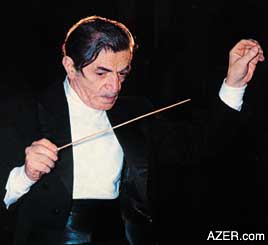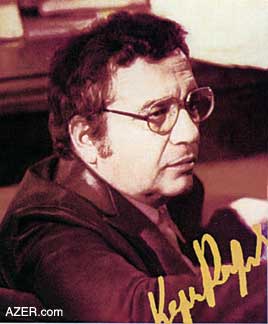|

Spring 2003 (11.1)
Pages
16-17
Newsmakers
Discoveries - Forgotten Music Scores from Famous Composers
by Alla Bayramova
Related articles
1 Remembering
Gara Garayev - A Legend in His Own Time - 80th Jubilee - Azad Sharifov
2 Gara
Garayev's 85th Jubilee
- Aida Huseinova
  Imagine having the chance to hear a
piece by one of your favorite composers for the first time-a
piece that no one had heard for decades. Azerbaijanis recently
had such an opportunity at concerts that featured unknown works
by composer Gara Garayev (1918-1982) and Maestro Niyazi (1912-1984). Imagine having the chance to hear a
piece by one of your favorite composers for the first time-a
piece that no one had heard for decades. Azerbaijanis recently
had such an opportunity at concerts that featured unknown works
by composer Gara Garayev (1918-1982) and Maestro Niyazi (1912-1984).
These rare compositions were rediscovered in 2000 in the archives
at the State Museum of Azerbaijani Musical Culture, which houses
a treasure trove of handwritten scores by 20th-century Azerbaijani
composers. The Museum's Director, Alla Bayramova, has been instrumental
in bringing these unpublished pieces to life again, much to the
delight of lovers of Azerbaijani music.
Forgotten Scores
In many cases, no one knew that these compositions
even existed. They had never been published or recorded. Music
historians had never included them in biographical notes or lists
of works. After the composer's death, they had completely been
forgotten-that is, until just recently.
  Left: Maestro Niyazi Left: Maestro Niyazi
Why were these works
never published? A number of explanations may account for their
obscurity, she says: "One possible reason is that the composer
didn't think the piece was important enough to publish, especially
if he was known for longer genres such as symphonies, ballets
and operas. But the fact that these works were not destroyed
or thrown away shows that they were somehow regarded as dear
to the composer.
"Some of these works were performed only for family or friends,
perhaps for a special occasion. For instance, in 1950, Gara Garayev
wrote a duet for Niyazi in honor of his birthday. Fittingly,
it was called 'Var ol, Niyazi!' (Long Live Niyazi!)."
Another possibility is that the composer was afraid that the
piece did not fit the spirit of Soviet ideology. "It's possible
that these works weren't published because the composer didn't
want to be accused of 'formalism'," Alla says. "We
have to keep in mind that artists weren't always free to do as
they wished during those times. The fact that these pieces have
survived makes it our responsibility to help make them known.
These pieces show how rich the works of our composers are, and
that there are so many new important details about our music
that still need to be investigated."
Works by Niyazi
One way that these unfamiliar works are becoming known is through
performances organized by the State Museum. "Once we started
rediscovering these wonderful forgotten works," Alla explains,
"it seemed like such a shame that they had never been performed
in public before."
  Left: One of Niyazi's scores that has recently been
found. Left: One of Niyazi's scores that has recently been
found.
One such piece is "Rags"
[pronounced "rax" which rhymes with "tax"],
meaning Dance, written by Niyazi in 1934 and dedicated to his
wife, Hajar. Musicologist Ludmila Karaghicheva mentioned that
Niyazi had incorporated Talysh national themes into his music
in the1959 book that she wrote. [The Talysh are a minority that
live near the Iranian border and speak a language related to
Persian.] However, none of Niyazi's pieces with Talysh themes
had ever been published or preserved. Now it seems that "Rags,"
which was written in the tradition of national music, may have
been one of the Talysh-themed pieces that Ludmila was referring
to more than 40 years ago.
"Rags" and several other unknown Niyazi pieces were
performed at Niyazi's 90th Jubilee, held in August 2002. Alla
Fyodorova, who works for the Museum, performed it, while pianist
Ulviyya Hajibeyova performed "Andantino" (1936), "Shutochka"
[Russian word for "Joke"](1929), "Etude"
(1932), and "Prelude" (1930).
  Left: Azerbaijani composer Gara Garayev. Left: Azerbaijani composer Gara Garayev.
As two of the pieces
had not been completed, Ulviyya's husband, composer Ismayil Hajibeyov,
worked to finish them. Ismayil is a member of the third generation
of the famous Hajibeyov family of musicians. See HAJIBEYOV.com.
A sixth untitled work by Niyazi was given the name "Miracle"
(1950) and performed by pianist Rena Rezayeva. She had played
this unknown piece in public even earlier as well for the Museum
in 2000, on the occasion of the 300th Jubilee Celebration of
the Piano which was held at Niyazi's Home Museum, one of the
branches of the State Museum. Rena also included this work on
her CD, which is entitled "Miracle."
The story of how Rena came across the piece is quite remarkable.
After Niyazi passed away, his widow Hajar let Rena-at the time,
a young pianist-work with his archive. Rena found the handwritten
score and persuaded Hajar to allow her to make a copy of it.
Rena kept her copy of the score and later had the opportunity
to perform the piece 50 years after it had been written. In 2001
Alla happened upon the original manuscript in Niyazi's archives.
Gara Garayev
Composer Gara Garayev's 85th Jubilee was celebrated in February
2003 [see related article in this issue]. In honor of his Jubilee,
Alla and her staff organized a concert to showcase works that
have been rediscovered in Garayev's archives at the Museum. Many
of the composer's students attended the concert, including Sevda
Ibrahimova, Ogtay Zulfugarov, Nariman Mammadov, Aziz Azizli,
Elnara Dadashova and Jalal Abbasova.
One of the pieces performed was a sonatina that Garayev had composed
in 1940, while he was in Moscow studying with the great symphonic
composer Dmitri Shostakovich [See article in this issue]. Ludmila
Karaghicheva's book about Gara Garayev, published in 1968, describes
the following work: "One-part Sonatina written by hand."
  Left: One of the six scores by Garayev that
has recently been discovered and performed. Left: One of the six scores by Garayev that
has recently been discovered and performed.
This appears to be the
same piece that has now been discovered in the archives.
"When Gara Garayev gave Ludmila information about his works,"
Alla says, "he also told her about this handwritten score,
which shows that he didn't want to exclude it from the list of
his works. Perhaps he didn't really consider it to be a 'student
work.'"
Another recently discovered work has been titled, "Andante
Sempre Rubato." "The piece didn't have a name,"
Alla says, "so we named it according to its tempo. Curiously,
it has somewhat of a jazz coloring. According to Faraj Garayev,
the composer's son, they had called this piece "Sketch"
among family members."
Untapped Archives
The State Museum of Azerbaijani Musical Culture consists of several
branches: the main building, which houses the archives, the home
museum of Niyazi, the home museum of mugham jazz composer Vagif
Mustafazade (1940-1979), and the permanent exposition of traditional
instruments found in the home of tar player Ahmad Bakikhanov
(1892-1973).
In its collections, the Museum has more than 35,000 items, including
traditional musical instruments, pianos, photographs, traditional
outfits and recordings as well as the personal pianos of Gara
Garayev and Muslim Magomayev (1885-1937).
Specific objects include the saz and national costume of famous
Ashig Sarajli (1916-1987), the tars of Gurban Primov (1880-1965)
and Habib Bayramov, (1926-1994) the gaval of Khan Shushinski
(1889-1965), the pitch pipe of Gurban Primov, and national costume
of Bahram Mansurov (1911-1985).
Most importantly, the Museum houses the archives for many renowned
Azerbaijani composers, including handwritten scores by composers
Jovdat Hajiyev (for example, the opera "Ayna" which
he composed together with Gara Garayev), Suleyman Alasgarov (1924-2000),
Tofig Guliyev (1917-2000), Vagif Mustafazade, Agshin Alizade
(1937- ).
Collecting the
Scores
In many cases, the composers gave their items from their individual
archives to the Museum while they were still alive. In other
cases, family members donated or sold papers and manuscripts
to the Ministry of Culture following the composer's death.
"The archives can be very scattered, with one page here
and another page there," Alla laments. "Some of the
pages aren't in good condition. Plus, since the scores are handwritten,
sometimes they are not very readable. Before we can make the
scores available to musicians, we'll have to edit them. How does
the Museum verify that a certain score was actually the work
of that composer? "In many cases, the piece was signed by
the composer," Alla says. "If not, we can compare handwriting
samples and tell if a work belongs to a certain composer. Likewise,
we don't always know the exact date that the piece was written.
If the date is not written on the score, we can only approximate
when the piece was written."
Resource for Musicians
For a handful composers, including Niyazi and Garayev, the Museum
has compiled a list of handwritten scores that are kept in the
archives. But this is only the beginning. Alla and her staff
hope to publish lists of works for many more of the composers.
"We want to publish these lists so that musicians will know
what we have," she explains. "Let's say someone is
searching for a specific work and doesn't know where to find
it. We might have it. On the other hand, we often receive requests
for scores that aren't found in our archives. We don't have everything-we
only have what has been given to us."
The Museum also wants to publish the scores of these works so
that contemporary musicians can perform them. For instance, Alla
would like to publish the Collection of 24 Preludes composed
by Jovdat Hajiyev (1917-2002) in 1934, but first she needs to
find financial support for the project.
"Music schools often ask us for copies of scores so that
their students can learn these pieces," she says. "Being
able to making them available to the public would greatly help
to enrich Azerbaijan's musical culture."
Alla Bayramova, Director of
the State Museum of Azerbaijani Musical Culture, was interviewed
by AI staff member Gulnar Aydamirova. On May 5, 2003, the Museum
will hold a concert, "Secrets and Unveilings," featuring
some of these new pieces.
SEARCH at AZER.com for biographical articles published in past
issues of Azerbaijan International magazine about composers mentioned
in this article: Garayev, Niyazi, Uzeyir Hajibeyov, Vagif Mustafazade,
Jovdat Hajiyev and Tofig Guliyev.
Back to Index AI 11.1 (Spring
2003)
AI Home
| Search | Magazine
Choice
| Topics
| AI Store | Contact us
Other Web sites
created by Azerbaijan International
AZgallery.org | AZERI.org | HAJIBEYOV.com
|





